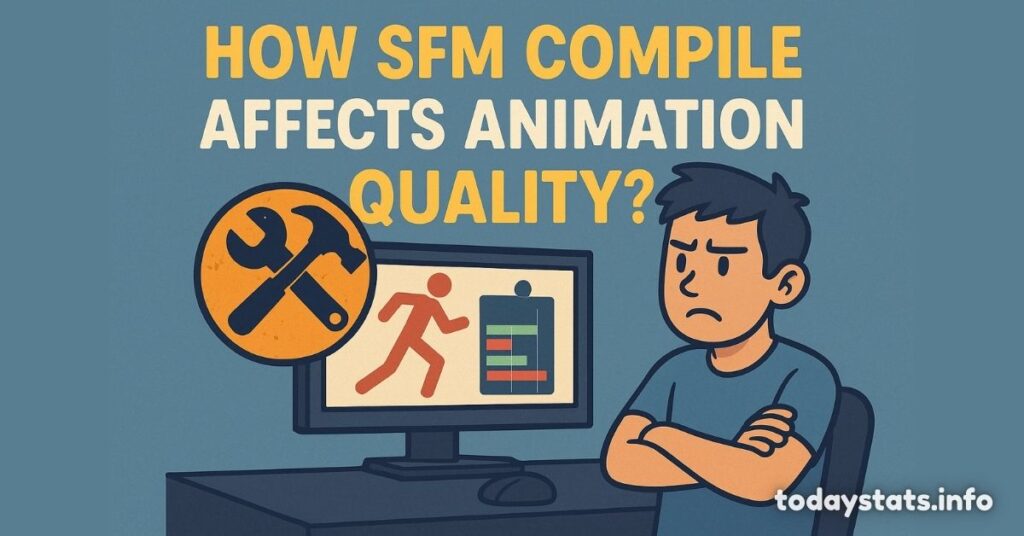If you’ve worked with Source Filmmaker, you’ve probably heard of SFM Compile. Whether you’re animating, tweaking models, or managing custom assets, SFM Compile helps streamline the process.
This guide breaks it down in simple terms so both beginners and developers can make the most of it in 2025.
Introduction: What is SFM Compile?
SFM Compile is a specialized tool designed to simplify the compilation process in Source Filmmaker (SFM). It is widely used by both users and developers for compiling models, textures, and other assets.
With this tool, managing and optimizing animation workflows becomes easier and more reliable. It provides greater control over how assets are prepared and integrated into projects.
What is SFM Compile?

SFM Compile refers to a set of utilities that convert raw files into a format compatible with the Source Engine. It helps transform 3D models and textures into usable formats such as Valve Texture Format (VTF).
The tool also manages the compiling of animation sequences, ensuring the final result is smooth and accurate.
The Role of SFM Compile in Source Filmmaker
In Source Filmmaker, the rendering and animation process depends heavily on well-compiled assets. Without tools like SFM Compile, users would have to rely on manual steps prone to errors.
This tool bridges that gap by automating key steps like model compilation, texture mapping, and asset conversion.
How SFM Compile Works?
SFM Compile uses a series of commands and scripts to process input files. It reads model sources, animation data, and texture images.
Then, it transforms them into a format readable by the Source Engine. Each process is logged, so developers can trace and fix problems when needed.
ALSO READ THIS BLOG: How to install 35-ds3chipdus3 and Why You Might Need It?
Key Features of SFM Compile
| Feature | Description |
| Batch Compilation | Allows users to compile multiple models or assets at once, saving valuable time. |
| Customizable Settings | Provides flexibility with compilation settings, including output formats and file paths. |
| Error Reporting | Detects and displays compile-time errors clearly, making debugging easier. |
| Command Line Interface | Supports CLI for advanced users to automate tasks and streamline the workflow. |
Installing SFM Compile
To get started with SFM Compile, users must download the latest version from the official community or SFM Compile Club. After extracting the files, they can follow the included setup guide. Make sure that the tool paths and Source SDK are configured correctly.
Setting Up SFM Compile for the First Time
First-time setup involves linking SFM Compile with the proper directories. Users must specify the locations for models, textures, and other input files.
Once the paths are set, a test compile should be run to ensure everything works. Correct setup prevents compilation errors later in the project.
Common Issues with SFM Compile
Users often encounter common issues such as missing textures, broken models, or syntax errors in the script. These problems usually arise from incorrect file names or misconfigured paths. Understanding the common pitfalls helps reduce delays during production.
Troubleshooting SFM Compile
When errors appear, checking the compile logs is essential. These logs indicate what went wrong and suggest possible fixes.
Users should also double-check file formats and ensure all dependencies are included. Rebuilding the asset from scratch can sometimes resolve hidden problems.
SFM Compile vs. Other Tools
| Feature | SFM Compile | Other Tools |
| Batch Compilation | Fully supported | Limited or not supported |
| Customization Options | Highly customizable settings | Often fixed or limited options |
| Error Reporting | Detailed and user-friendly | Basic or unclear error messages |
| Command Line Interface | Full CLI support | Some lack CLI capabilities |
| Source Filmmaker Integration | Seamlessly integrated | May require manual configuration |
| Performance Speed | Optimized for multi-task processing | May be slower with larger files |
| Support for Custom Assets | Broad support, including textures | Often requires additional setup |
| Ease of Use | Beginner to advanced friendly | Can be complex or outdated |
Understanding Compile Logs in SFM Compile
Every time you compile with SFM Compile, a log file is created. This document includes valuable data like compile duration, warnings, and detailed errors.
Learning to read these logs can help you become more efficient. They are your first line of defense against project-breaking bugs.
SFM Compile Commands You Need to Know
Several commands are essential for mastering SFM Compile. These include commands for batch operations, error checking, and preview generation.
Becoming familiar with these helps automate repetitive tasks and fine-tune the output. Advanced users often write scripts to speed up the process even more.
Best Practices for Using SFM Compile
Start by organizing your files into clear folders. Make sure your models, textures, and scripts are named consistently. Always compile small portions first to identify issues early.
Keep a backup of working assets. These habits lead to a smoother compilation process and fewer delays.
How SFM Compile Affects Animation Quality?

The way assets are compiled directly influences how animations look and behave. Poorly compiled models can cause jerky movements or texture glitches.
SFM Compile ensures that animation sequences are smooth and responsive. Proper settings also optimize frame rendering in the final output.
Advanced SFM Compile Features
Advanced users can take advantage of multi-threaded compilation, custom compile scripts, and asset preloading.
These features speed up complex projects and allow developers to focus more on creativity than technical challenges. Learning these tools takes time but greatly improves output.
ALSO READ THIS BLOG: Innovation News DualMedia: Shaping Tomorrow’s Breakthroughs Today
SFM Compile and Custom Assets
When using custom models or third-party textures, SFM Compile makes integration easy. You simply point the tool to the custom directory and start the compile process.
It supports various file types used in 3D modeling, ensuring compatibility with the Source Engine. Asset integration becomes seamless with the right setup.
Frequently Asked Questions
What files can SFM Compile handle?
It can process model files, texture images, animation data, and scripts needed for Source Filmmaker.
Is SFM Compile beginner-friendly?
Yes, but beginners should follow setup guides and tutorials to avoid common mistakes.
Can I use SFM Compile with custom textures?
Absolutely. Just make sure the textures are in the correct format and directory.
Why are my textures missing after compilation?
This often happens due to incorrect file paths or unsupported formats.
Does SFM Compile support updates?
Yes, the community regularly updates the tool with new features and fixes.
Conclusion
SFM Compile is a vital tool for anyone working with Source Filmmaker. Whether you’re compiling assets, optimizing animations, or integrating custom files, this tool simplifies every step.
It improves workflow, reduces errors, and enhances the overall quality of your work. By understanding its features, mastering commands, and following best practices, users can unlock the full potential of their animation projects.
With tools like SFM Compile, creative ideas turn into polished animations, ready to be shared with the world.

Smith is a seasoned SEO expert with a passion for content writing, keyword research, and web development. He combines technical expertise with creative strategies to deliver exceptional digital solutions.
















